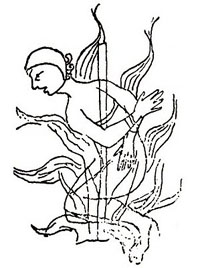Cathars and Cathar Beliefs in the Languedoc
|
| |||||||||||||||||||||||||||||||||||||||||||||||||||||||||||||||||||||||||||||||||||||||||||||||||||||||||||||||||||||||||||||||||||||||||||||||||||||||||||||||||||||||||||||||||||||||||||||
|
|
|
|
|
|
||||||||||||||||||||||||||||||||||||||||||||||||||||||||||||||||||||||||||||||||||||||||||||||||||||||||||||||||||||||||||||||||||||||||||||||||||||||||||||||||||||||||||||||||||||||||
|
|
|||||||||||||||||||||||||||||||||||||||||||||||||||||||||||||||||||||||||||||||||||||||||||||||||||||||||||||||||||||||||||||||||||||||||||||||||||||||||||||||||||||||||||||||||||||||||||||
|
|
Encyclopaedia Britannica, 11th Edition, Volume 5, "Cat"
to "Celt"
|
||||||||||||||||||||||||||||||||||||||||||||||||||||||||||||||||||||||||||||||||||||||||||||||||||||||||||||||||||||||||||||||||||||||||||||||||||||||||||||||||||||||||||||||||||||||||||||
| Webmaster notes | |
|
CATHARS (CATHARI or CATHARISTS), a widespread heretical sect of the middle ages. They were the debris of an early Christianity, scattered in the 10th to 14th centuries over East and West, having their analogues in the Mahommedan world as well. In the East they were called Bogomils (q.v.) and Paulicians; in the West, Patarenes, Tixerands (i.e. Weavers), Bulgars, Concorricii, Albanenses, Albigeois, &c.; in both, Cathars and Manicheans. This article relates to the Western Cathars, as they appear (1) in the Cathar Ritual written in Provencal and preserved in a 13th-century MS. in Lyons, published by Cledat, Paris, 1888; (2) in Bernard Gui's Practica inquisitionis haereticae pravitatis, edited by Canon C. Douais, Paris, 1886; and (3) in the proces verbal of the Inquisitors' reports. Some were downright dualists, and believed tat there are two gods or principles, one of good and the other of evil, both eternal; but as a rule they subordinated the evil to the good. All were universalists in so far as they believed in the ultimate salvation of all men.[1] |
|
|
Their tenets were as follows:--The evil god, Satan, who inspired the malevolent parts of the Old Testament, is god and lord of this world, of the things that are seen and are temporal, and especially of the outward man which is decaying, of the earthen vessel, of the body of death, of the flesh which takes us captive under the law of sin and desire. This world is the only true purgatory and hell, being the antithesis of the world eternal, of the inward man renewed day by day, of Christ's peace and kingdom which are not of this world. Men are the result of a primal war in heaven, when hosts of angels incited by Satan or Lucifer to revolt were driven out, and were imprisoned in terrestrial bodies created for them by the adversary. But there are also celestial bodies, bodies spiritual and not natural. These the angel souls left behind in heaven, and they are buildings from God, houses not made with hands, tunics eternal. Imprisoned in the garment of flesh, burdened with its sin, souls long to be clothed upon with the habitations they left in heaven. So long as they are at home in the body, they are absent from the Lord. They would fain be at home with the Lord, and absent from the body, for which there is no place in heaven since flesh and blood cannot inherit the kingdom of God, nor corruption inherit incorruption. There is no resurrection of the flesh. The true resurrection is the spiritual baptism bequeathed by Christ to the boni homines. How shall man escape from his prison-house of flesh, and undo the effects of his fall? For mere death brings no liberation, unless a man is become a new creation, a new Adam, as Christ was; unless he has received the gift of the spirit and become a vehicle of the Paraclete. If a man dies unreconciled to God through Christ, he must pass through another cycle of imprisonment in flesh; perhaps in a human, but with equal likelihood in an animal's body. For when after death the powers of the air throng around and, persecute, the soul flees into the first lodging of clay that it finds.[2] Christ was a life-giving spirit, and the boni homines, the "good men," as the Cathars called themselves, are his ambassadors. They alone have kept the spiritual baptism with fire which Christ instituted, and which has no connexion with the water baptism of John; for the latter was an unregenerate soul, who failed to recognize the Christ, a Jew whose mode of baptism with water belongs to the fleeting outward world and is opposed to the kingdom of God. It would be interesting to trace Bardesanes and the Syriac Hymn of the Soul in all this. |
"prison-house of flesh" |
|
The Cathars fell into two classes, corresponding to the Baptized and the Catechumens of the early church, namely, the Perfect, who had been "consoled," i.e. had received the gift of the Paraclete; and the credentes or Believers. The Perfect formed the ordained priesthood, were women no less than men, and controlled the church; they received from the Believers unquestioning obedience, and as vessels of election in whom the Holy Spirit already dwelt, they were adored by the faithful, who were taught to prostrate themselves before them whenever they asked for their prayers. For none but the Consoled had received into their hearts the spirit of God's Son, which cries "Abba, Father." They alone were become adopted sons, and so able to use the Lord's Prayer, which begins, "Our Father, which art in heaven." The Perfect alone knew God and could address him in this prayer, the only one they used in their ceremonies. The mere credens could at best invoke the living saint, and ask him to pray for him. |
"They alone were become adopted sons, and so able to use the Lord's Prayer" |
|
All adherents of the sect seem to have kept three Lents in the year, as also to have fasted Mondays, Wednesdays and Fridays of each week; in these fasts a diet of bread and water was usual. But a credens under probation for initiation, which lasted at least one and often several years, fasted always. The life of a Perfect was so hard, and, thanks to the Inquisitors, so fraught with danger, that most Believers deferred the rite until the death-bed, as in the early centuries many believers deferred baptism. The rule imposed complete chastity. A husband at initiation left his wife, committing her "to God and the gospel"; a wife her husband. A male Perfect could not lay his hand on a woman without incurring penance of a three-days' fast. All begetting of children is evil, for Adam's chambering with Eve was the forbidden fruit. It is good for a man not to touch a woman; a man's relations with his own wife are merely a means of fornication, and marriage and concubinage are indistinguishable as against the kingdom of God, in which there is no marrying or giving in marriage. Those only have been redeemed from earth who were virgins, undefiled with women. The passages of the New Testament which seem to connive at the married relation were interpreted by the Cathars as spoken in regard of Christ and the church. The Perfect must also leave his father and mother, and his children, for a man's foes are they of his own household. The family must be sacrificed to the divine kinship. He that loveth father or mother more than Christ is not worthy of him, nor he that loveth more his son or daughter. The Perfect takes up his cross and follows after Christ. |
three Lents in the year "marriage and concubinage are indistinguishable as against the kingdom of God, in which there is no marrying or giving in marriage"
|
|
Next he must abstain from all flesh diet except fish. He may not even eat cheese or eggs or milk, for they, like meat, are produced per viam generationis seu coitus. Everything that is sexually begotten is impure. Fish were supposed to be born in the water without sexual connexion, and on the basis of this old physiological fallacy the Cathars equally with the Catholic framed their rule of fasting. And there was yet another reason why the Perfect should not eat animals, for a human soul might be doing time in its body. Nor might a Perfect or one in course of probation kill anything, for the Mosaic commandment applies to all life. He might not lie nor take an oath, for the precept "Swear not at all" was, like the rest of the gospel, taken seriously. This was the chief of their "anarchist doctrines."[3] |
|
|
The Cathar rites, which remain to us in a manual of the sect, "recall," says the Abbe Guiraud, no too favourable a witness, "those of the primitive church with a truth and precision the more striking the nearer we go back to the apostolic age." The medieval Inquisitor saw in them an aping of the rites of the Catholic church as he knew them; but they were really, says the same authority, "archaeological vestiges (i.e. survivals) of the primitive Christian liturgy. In the bosom of medieval society they were the last witness to a state of things that the regular development of Catholic cult had amplified and modified. They resemble the erratic blocks which lost amid alien soils recall, where we find them, the geological conditions of earlier ages. This being so, it is of the deepest interest to study the Cathar cult, since through its rites we can get a glimpse of those of the primitive church, about which want of documents leaves us too often in the dark." |
"In the bosom of medieval society they were the last witness to a state of things that the regular development of Catholic cult had amplified and modified" |
|
The central Cathar rite was consolamentum, or baptism with spirit and fire. The spirit received was the Paraclete derived from God and sent by Christ, who said, "The Father is greater than I." Of a consubstantial Trinity the Cathars naturally had never heard. Infant baptism they rejected because it was unscriptural, and because all baptism with water was an appanage of the Jewish demiurge Jehovah, and as such expressly rejected by Christ. |
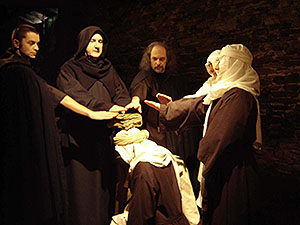 |
|
The consolamentum removes original sin, undoes the sad effects of the primal fall, clothes upon us our habitation which is from heaven, restores to us the lost tunic of immortality. A Consoled is an angel walking in the flesh, whom the thin screen of death alone separates from Christ and the beatific vision. The rite was appointed by Christ, and has been handed down from generation to generation by the boni homines. |
|
|
The long probation called "abstinence" which led up to it is a survival of the primitive catechumenate with its scrutinies. The prostrations of the credens before the Perfect were in their manner and import identical with the prostrations of the catechumen before the exorcist. We find the same custom in the Celtic church of St Columba. Just as at the third scrutiny the early catechumen passed a last examination in the Gospels, Creed and Lord's Prayer, so after their year of abstinence the credens receives creed and prayer; the allocution with which the elder "handed on" this prayer is preserved, and of it the Abbe Guiraud remarks that, if it were not in a Cathar ritual, one might believe it to be of Catholic origin. It is so Christian in tone, he quaintly remarks elsewhere, that an Inquisitor might have used it quite as well as a heretic. In it the Perfect addresses the postulant, as in the corresponding Armenian rite, by the name of Peter; and explains to him from Scripture the indwelling of the spirit in the Perfect, and his adoption as a son by God. The Lord's Prayer is then repeated by the postulant after the elder, who explains it clause by clause; the words panis superstantialis being interpreted not of the material but of the spiritual bread, which consists of the Words of Life. |
|
|
There followed the Renunciation, primitive enough in form, but the postulant solemnly renounced, not Satan and his works and pomp, but the harlot church of the persecutors, whose prayers were more deadly than desirable. He renounced the cross which its priests had signed on him with their chrism, their sham baptisms and other magical rites. Next followed the spiritual baptism itself, consisting of imposition of hands, and holding of the Gospel on the postulant's head. The elder begins a fresh allocution by citing Matt. xxviii. 19, Mark xvi. 15, 16, John iii. 3 (where the Cathars' text must originally have omitted in v. 5 the words "of water and," since their presence contradicts their argument). Acts ix. 17, 18, viii. 14-17, are then cited; also John xx. 21-23, Matt. xvi. 18, 19, Matt. xviii. 18-20, for the Perfect one receives in this rite power to bind and loose. The Perfect's vocation is then defined: he must not commit adultery nor homicide, nor lie, nor swear any oath, nor pick and steal, nor do unto another that which he would not have done unto himself. He shall pardon his wrongdoers, love his enemies, pray for them that calumniate and accuse him, offer the other cheek to the smiter, give up his mantle to him that takes his tunic, neither judge nor condemn. Asked if he will fulfil each of these, the postulant answers: "I have this will and determination. Pray God for me that he give me his strength." |
|
|
The next episode of the rite exactly reproduces the Roman confiteor as it stood in the 2nd century; "the postulant says: 'Parcite nobis. For all the sins I have committed, in word or thought or deed, I come for pardon to God and to the church and to you all.' And the Christians shall say: 'By God and by us and by the church may they be pardoned thee, and we pray God that he pardon you them.'" |
|
|
There follows the act of "consoling." The elder takes the Gospel off the white cloth, where it has lain all through the ceremony, and places it on the postulant's head, and the other good men present place their right hands on his head; they shall say the parcias (spare), and thrice the "Let us adore the Father and Son and Holy Spirit," and then pray thus: "Holy Father, welcome thy servant in thy justice and send upon him thy grace and thy holy spirit." Then they repeat the "Let us adore," the Lord's Prayer, and read the Gospel (John i. 1-17). |
|
|
This was the vital part of the whole rite. The credens is now a Perfect one. He is girt with the sacred thread round his naked body under the breasts. Where the fear of the persecutor was absent he was also clad in a black gown. The Perfect ones present give him the kiss of peace, and the rite is over. This part of the rite answers partly to the Catholic confirmation of a baptized person, partly to the ordination of a pope of Rome or Alexandria. The latter in being ordained had the Gospel laid on their heads, and the same feature occurs in old Gallican and Coptic rites of ordaining a bishop. |
"This part of the rite answers partly to the Catholic confirmation of a baptized person, partly to the ordination of a pope of Rome or Alexandria. The latter in being ordained had the Gospel laid on their heads, and the same feature occurs in old Gallican and Coptic rites of ordaining a bishop." |
|
Thus the Cathar ritual, like that of the Armenian dissenters (see PAULICIANS), reflects an age when priestly ordination was not yet differentiated from confirmation. "Is it not curious," says the Abbe Guiraud, "to remark that the essential rite of the consolamentum is in effect nothing but the most ancient form of Christian ordination?" |
"the essential rite of the consolamentum is in effect nothing but the most ancient form of Christian ordination" |
|
The Cathar Eucharist was equally primitive, and is thus described by a contemporary writer in a 13th-century MS. of the Milan Library:-- "The Benediction of bread is thus performed by the Cathars. They all, men and women, go up to a table, and standing up say the 'Our Father.'[4] And he who is prior among them, at the close of the Lord's Prayer, shall take hold of the bread and say: 'Thanks be to the God of our Jesus Christ. May the Spirit be with us all.' And after that he breaks and distributes to all. And such bread is called bread blessed, although no one believes that out of it is made the body of Christ. The Albanenses, however, deny that it can be blessed or sanctified, because it is corporeal" (i.e. material). |
or "blessed bread" |
|
As Tertullian relates of his contemporaries in the 2nd century, so the Cathars would reserve part of their bread of blessing and keep it for years, eating of it occasionally though only after saying the Benedicite. The Perfect kept it wrapped up in a bag of pure white cloth, tied round the neck,[5] and sent it long distances to regions which through persecution they could not enter. On the death-bed it could even, like the Catholic Viaticum, take the place of the rite of Consolamentum, if this could not be performed. Once a month this solemn rite of breaking bread was held, the credentes assisting. The service was called apparellamentum, because a table was covered with a white cloth and the Gospel laid on it. The Perfect were adored, and the kiss of peace was passed round. |
Viaticum |
|
The influence of Catharism on the Catholic church was enormous. To counteract it celibacy was finally imposed on the clergy, and the great mendicant orders evolved; while the constant polemic of the Cathar teachers against the cruelty, rapacity and irascibility of the Jewish tribal god led the church to prohibit the circulation of the Old Testament among laymen. The sacrament of "extreme unction" was also evolved by way of competing with the death-bed consolamentum. |
"The influence of Catharism on the Catholic church was enormous" |
|
AUTHORITIES-
|
|
|
|
|
|
FOOTNOTES: [1] A certain Peter (Doc. Doat., 22, p. 98) declared that could he but get hold of the false and perfidious God of the Catholics who created a thousand men in order to save a single one and damn all the rest, he would break him to pieces and tear him asunder with his nails and spit in his face. [2] Here we have a doctrine of metempsychosis which seems of Indian origin (see ASCETICISM). But Julius Caesar (de B.G. vi. 13) attests this belief among the ancient Druids of Gaul. [3] The Abbe Guiraud remarks that in refusing to take oaths the Cathars "contraried the social principles on which the constitutions of all states repose," and congratulates himself that society is not yet so thoroughly "laicized" as to have given up oaths in the most important acts of social life. [4] Cf. S. Gregorii Ep. ix. 12 (26): "Mos apostolorum fuit ut ad ipsam solummodo orationem oblationis hostiam consecrarent." ("The custom of the apostles was to use no other prayer but the Lord's in consecrating the host of the offering.") [5] Cf. Duchesne, Origines, ed. 1898, p. 177.
|
|
|
|
|
Around 1250 Alphonse de Poitiers wrote to Pope Innocent IV asking him to issue a bull against heresy. This document is known in the form of a draft, on the back of which is a sketch showing a man being burned at the stake.
Alphonse's draft letter is held in the French National Archives, in a dossier called "Grands documents de l'histoire de France; Florilège", No notice 00000192, Fonds MUS, Cote AE/II/257 (Cote origine J428/1): described as "Projet de texte rédigé pour Alphonse de Poitiers, comte de Toulouse, afin d'obtenir du pape Innocent IV une bulle sur les poursuites contre les hérétiques. Au verso figure le dessin d'un hérétique livré aux flammes. Document non daté, en latin." |
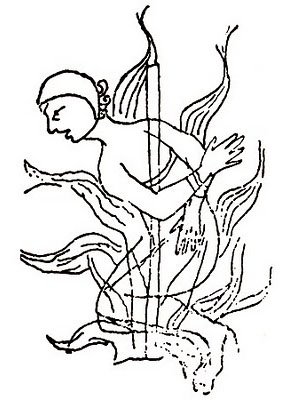 |
|
Franciscans watching a Cathar Consolamentum |
 |
|
Jean-Paul Laurens (1838-1921) |
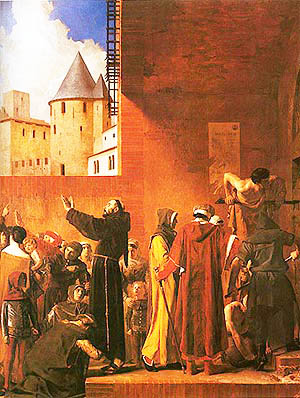 |
 |
|
Road sign commemorating a Cathar Council at Pieusse |
 |
|
Carcassonne - Château Comtal |
 |
|
Villerouge Termenes - staircase built within the thickness of a tower wall |
 |
|
Medieval window seat at Villerouge Termenes where the last known Cathar Parfait in the Languedoc was burned alive for disagreeing with Catholic theology. |
 |
|
Montsegur where around 325 Cathars were burned alive for disagreeing with Catholic theology |
 |
|
Saint Augustine of Hippo - an ex Manichaean |
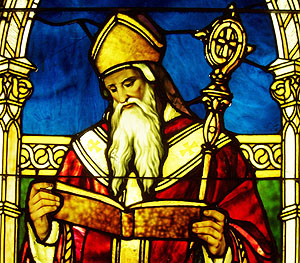 |
 |
|
Capitol, Toulouse |
 |
|
Commemorative plaque at Lavaur where around 400 Cathars were burned alive for disagreeing with Catholic theology. |
 |
|
Pope Innocent III with Raymond VII, Count of Toulouse |
 |
|
Memorial at Les Casses where 60 Cathars were burned alive |
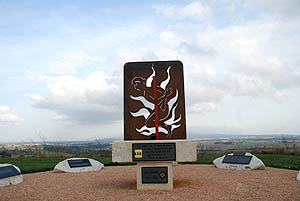 |
|
Franciscan Friars witness a Cathar Consolamentum |
 |
|
Figure on the Basilica at Carcassonne |
 |
|
The King of Aragon wearing his "Coat of arms" |
 |
|
Cité of Carcassonne |
 |
|
Auto Da Fe Presided Over by Saint
Dominic de Guzmán (1475); Pedro Berruguete (around
1450-1504) commissioned by Torquemada, Oil on wood . 60 5/8
x 36 1/4 (154 x 92 cm). |
 |
|
Burning Cathar "heretics" at Montsegùr |
 |
|
Road sign in Béziers |
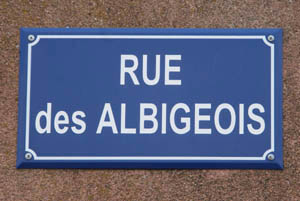
|
|
Jean-Paul Laurens (1838-1921) (depicting the Franciscan Bernard de Delicieus facing the Inquisition) |
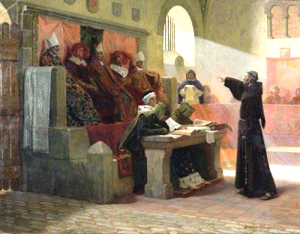 |
|
Cathars and Catholics Expelled from Carcassonne |
 |
 |
 |
|
Memorial at Minerve where 140 - 180 Cathars were burned alive for disagreeing with Catholic theology. |
 |
 |
|
Villerouge Termenes where the last known Cathar Parfait in the Languedoc was burned alive for disagreeing with Catholic theology. |
 |
|
Barbican, Aude Gate, Carcassonne |
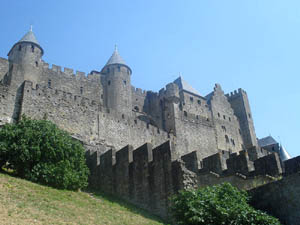 |
 |
 |
|
Commemorative plaque at Lavaur where around 400 Cathars were burned alive for disagreeing with Catholic theology. |
 |
|
Painting in the Halle des Illustres at Toulouse depicting the death of Simon de Montfort |
 |
|
Figure on the Basilica at Carcassonne |
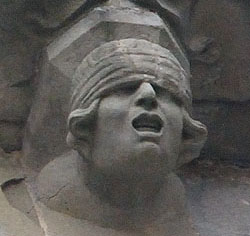 |
|
MedievalTrebuchet stones (at Carcassonne) |
 |
|
The King of France wearing his "Coat of Arms" |
 |
|
Raymond
VII, Count
of Toulouse |
 |
|
Auto Da Fe Presided Over By Saint
Dominic de Guzmán (1475); Pedro Berruguete (around
1450-1504) commissioned by Torquemada, Oil on wood . 60 5/8
x 36 1/4 (154 x 92 cm). |
 |
|
Saint Augustine of Hippo, an ex Manichaean, trampling other Manichaeans underfoot |
 |
|
Dominic Guzmán (with a halo), Arnaud Amaury, and other Cistercian abbots crush helpless Cathars underfoot - a sanitised version of the persecution of the Cathars |
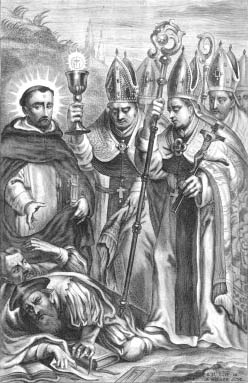 |
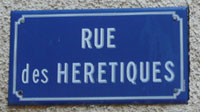 |
 |
 |
 |
|
Barbican, Aude Gate, Carcassonne |
 |
|
Eastern Manichaeans |
 |
|
Saint Dominic [Dominic Guzmán] and the Albigenses, 1480, Pedro Berruguete (Museo del Prado). |
 |
|
Raymond IV, Count of Toulouse |
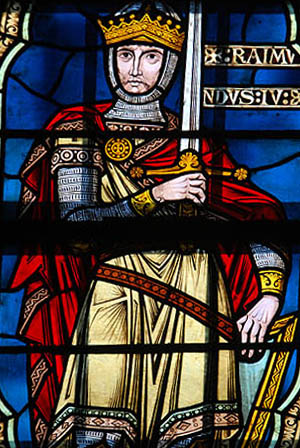 |
|
Nicola Pisano, Cathar "heretics" before Dominic Guzmán at the (fictitious) Dispute of Fanjeaux |
 |
|
Commemorative Road Sign at Minerve where 140 - 180 Cathars were burned alive for disagreeing with Catholic theology. |
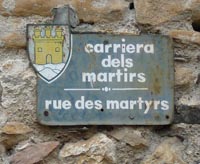 |
|
Béziers where the Abbot-Comander Arnaud Amaury reported killing 20,000 without regard to age, sex or rank. |

|
|
Flags in Béziers |
 |
|
Figure on the Basilica at Carcassonne |
 |
|
Road sign in Béziers |
 |
|
The Count of Toulouse wearing his "Coat of arms" |
 |
|
A modern recreation of the Cathar Ceremoniy of the Consolamentum |
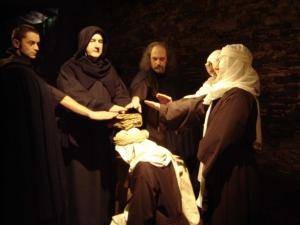 |
Further Information on Cathars and Cathar Castles
|
If you want to cite this website in a book or academic paper, you will need the following information: Author: James McDonald MA, MSc.
If you want to link to this site please see How to link to www.cathar.info
For media enquiries please e-mail james@cathar.info
|


| CATHAR BELIEFS | CATHAR WARS | CATHOLIC CHURCH | CATHAR INQUISITION | CATHAR CASTLES | CATHAR ORIGINS | CATHAR LEGACY | CATHAR TOURS | CATHAR BOOKS | WHO's
WHO |
CATHAR TIMELINE | MORE INFO |
CATHAR GLOSSARY | CATHAR NEWS |
| |
| |
| |
| |
| |
| :::: Link to www.cathar.info ::: © C&MH 2010-2016 ::: contact@cathar.info ::: Advertising ::: |




